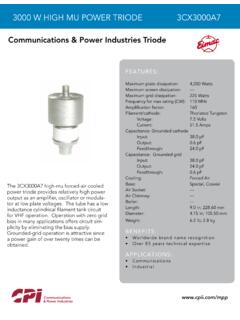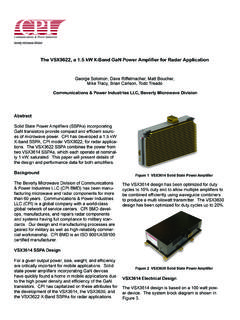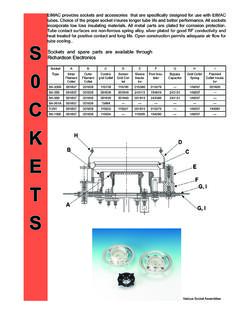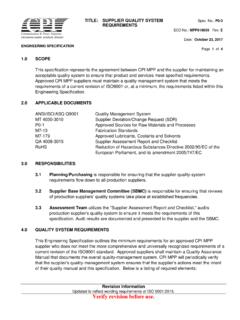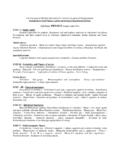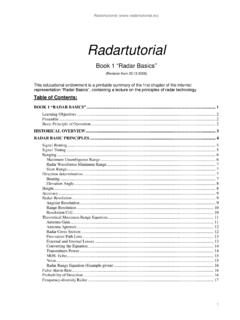Transcription of Magnetron Theory of Operation - cpii.com
1 Magnetron Theory of & Power Industries Magnetron Theory of OperationA Magnetron is a high power microwave oscillator in which the potential energy of an electron cloud near the cathode is converted into energy in a series of cavity resonators similar to the one shown in Figure 1. As depicted by the low frequency analog, the rear wall of the structure may be consid-ered the inductive portion, and the vane tip region the capacitor portion of the equivalent resonant circuit. The resonant frequency of a microwave cavity is thereby determined by the physical dimen-sion of the resonator together with the reactive effect of any perturbations to the inductive or capacitive portion of the equivalent circuit. This is an important point and will be recalled 1 Magnetron ResonatorFigure 2 EnergyTransferMechanismIn order to sustain oscillations in a resonant circuit, it is necessary to continuously input energy in the correct phase.
2 Referring to Figure 2, if the instanta-neous field, due to steady state oscillations in the resonator, is in the direction shown, and, an electron with velocity was to travel through the field such that the field retarded the electron velocity by an amount, the decrease in electron energy will be exactly offset by an increase in the field a Magnetron , the source of electrons is a heated cathode located on the axis of an anode structure containing a number of microwave resonators. See Figure 3. Electrons leave the cathode and are accelerated toward the anode, due to the dc field established by the voltage source E. The presence of a strong magnetic field B in the region between cathode and anode produces a force on each electron which is mutually perpendicular to the dc field and the electron velocity vectors, thereby causing the electrons to spiral away from the cathode in paths of varying curvature, depending upon the initial electron velocity a the time it leaves the 3 Anode/CathodeStructureMagnetron Theory of Operation pg.
3 2As this cloud of electrons approaches the anode, it falls under the influence of the RF fields at the vane tips, and electrons will either be retarded in veloci-ty, if they happen to face an opposing field, or accelerated if they are in the vicinity of an aiding field. Since the force on an electron due to the magnetic field B is proportional to the electron velocity through the field, the retarded velocity electrons will experience less "curling force" and will therefore drift toward the anode, while the accelerated velocity electrons will curl back away from the anode. The result is an automatic collection of electron "spokes" as the cloud nears the anode (see Figure 4), with each spoke located at a resonator having an opposing RF the next half cycle of oscillation, the RF field pattern will have reversed polarity and the spoke pattern will rotate to main-tain its presence in an opposing field.
4 The "automatic" synchronism between the elec-tron spoke pattern and the RF field polarity in a crossed field device allows a Magnetron to main-tain relatively stable Operation over a wide range of applied input parameters. For example, a magne-tron designed for an output power of 200 kW peak will operate quite well at 100 kw peak output by simply reducing the modulator drive will note that the instantaneous RF field pattern, shown in Figure 4, has exactly 180 of phase Figure 4 Electronspokes in a magnetronchange (radians) between every adjacent pair of resonator vanes and is therefore called the mode. Other oscillation patterns (modes) could be support-ed by the anode structure; however, the mode pattern will product the maximum number of elec-tron spokes, and therefore the maximum transfer of energy to the RF field, , highest efficiency mode.
5 Assuring that the Magnetron maintains mode oscil-lation, to the exclusion of all other modes, is one of the prime concerns of the Magnetron mode controlling techniques in a conventional Magnetron , , electrically connecting alternate vane tips together to assure identical potential, employing geometrical similarities between alter-nate resonators to favor mode oscillation, will ade-quately maintain mode control in conventional mag-netron anodes. Due to mode separation parame-ters, the number of resonators in conventional mag-netron anodes is limited and rarely exceeds 20 reso-nator vanes. Since the physical size of each resona-tor is fixed by the desired output frequency, the overall size of the anode is limited, thereby restrict-ing cathode dimensions and heat dissipation capaci-ty. The result is that at higher frequencies the conventional Magnetron has reduced power output capability, lower reliability and a shorter operating lifetime than can be realized at the lower microwave distinguishing feature of the coaxial Magnetron is the presence of a high Q stabilizing cavity between the anode and the output waveguide.
6 The Theory of Operation presented for a convention-al Magnetron applies equally to the anode-cathode region of the coaxial structure. However, the coaxial stabilizing cavity affords very significant improve-ments in overall Magnetron Theory of Operation pg. mode control: Operating the cavity in the TE011 mode, and slot coupling alternate anode resonators to the cavity, produces anode control of such intensity as to permit the construction of coaxi-al magnetrons with many times the number of reso-nators that can be employed in a conventional type Magnetron . This means lower cathode emission density, lower life and higher RF fields in the anode: Whereas all stored energy in a conventional is confined to the vane resonators, in a coaxial Magnetron approximately 85% of the total stored energy is contained in the stabilizing cavity.
7 This means reduced RF field inten-sity at the vane tips, and less tendency to frequency stability: The redistribution of stored energy in the coaxial Magnetron makes the high Q stabilizing cavity the prime determiner of Magnetron output frequency. This means a lower pushing figure, a lower pulling figure, improved spectrum and reduced spurious tuning: In the conventional Magnetron , tuning is accomplished by inserting inductive pins in the rear portion of each resonator, or by capacitiveloading in the vane tip region. Both techniques represent an adverse perturbation to the natural geometry of the resonators which often results in power output variation with tuning, starting instabilities, increased susceptibility to arcing and a generally reduced operating lifetime for the Magnetron . In contrast the coaxial Magnetron is tuned by moving a noncontacting plunger in the stabilizing cavity (see Figure 5).
8 The result is a tuning characteristic with no discontinuities, broad tunable bandwidth, and none of the disadvantages resulting from perturbations in the anode-cathode region. Figure 5: Coaxial MagnetronFigure 6: Three types of tuning schemes used in conventional Magnetron resonator systemsTypical Magnetron ParametersThe following is a discussion and explanation of typi-cal Magnetron specification DriftAt the time high voltage is first applied to a magnetr-ton, the thermal equilibrium of the device is sudden-ly altered. The anode vanes being to heat at the tips due to electron bombardment and the entire anode/cathode structure undergoes a transient Magnetron Theory of Operation pg. in thermal profile. During the time required for each part of the Magnetron to stabilize at its normal operating temperature, the output frequency of the Magnetron will "drift.
9 " The curve of output frequency vs. time during the period following initial turn on is called the "Thermal Drift" curve. Generally speaking, the maximum drift occurs during the first few minutes after turn on, and slowly approaches equilibrium over a period ranging from 10 to 30 minutes depending upon the structure mass, power output, type of cooling and basic Magnetron design. Thermal drift curves across a variety of Magnetron types operating at the same frequency and output power may differ radically from each other. Each type is usually designed for a particular purpose and subtle differences in the internal Magnetron configuration can produce radical differences in the thermal drift should be noted that a thermal drift effect will occur not only at initial turn-on, but whenever the peak or average input power to the Magnetron is changed, , a change of pulse duration, PRF or duty.
10 Figure 7 shows typical thermal drift curves for a particular Magnetron plotted as a function of duty. The dotted line indicates the effect of a change in duty from .001 to .0005 after thermal equilibrium has been initially achieved. Temperature CoefficientAfter the thermal drift period has expired and a stable operating frequency has been achieved, changes to ambient conditions which cause a corre-sponding change in the Magnetron temperature will produce a change in the output frequency. In this content ambient changes include cooling air temperature or pressure in air cooled magnetrons; mounting plate temperature in heat sink cooled magnetrons; and flow rate or temperature in liquid cooled change in Magnetron output frequency for each degree change in body temperature, as mea-sured at a specified point on the outside surface of the Magnetron body, is defined as the Temperature Coefficient for the Magnetron and is usually expressed in MHz/oC.
